Bird and wildlife rescue, rehab and educational organizations deserve our support and there are many ways we can provide it.
Three days ago veteran blog follower Arwen Lynch-Poe made the following comment on my Ferruginous Hawk post. It wasn’t made until very late in the day and I’m pretty sure it wasn’t seen by most readers so I’m including it below.
- “Because of my love of raptors and your amazing blog, I’m going to be cleaning mews on Tuesday at a local raptor rescue (Hawks Aloft). So thank you for all that you do.”
Arwen’s comment was the inspiration for this post.
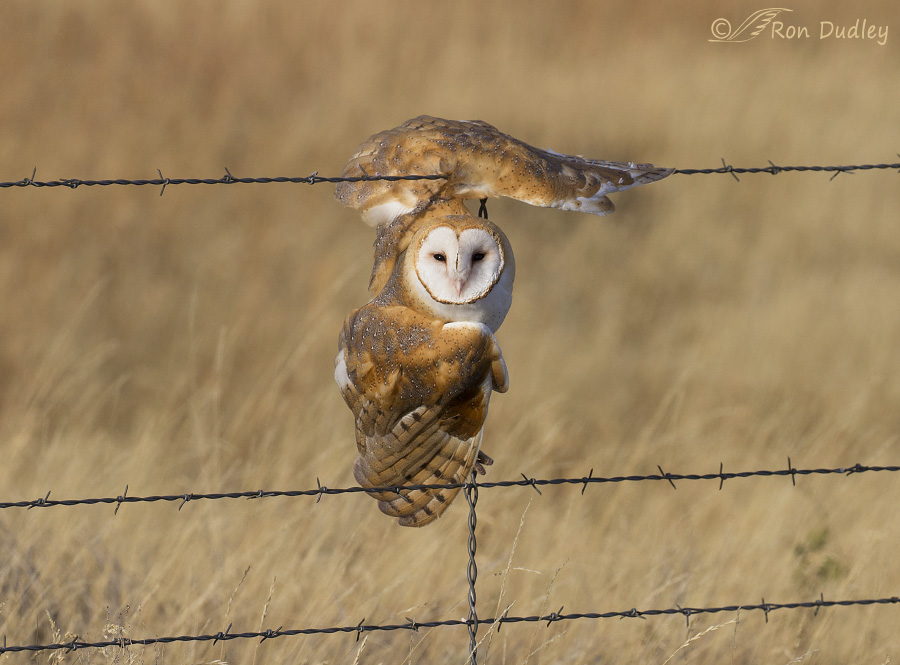
Many readers will remember this beautiful Barn Owl that Mia and I found hanging from barbed wire five years ago in southwest Montana’s Centennial Valley. His left wing was so badly entangled in the wire I couldn’t free the bird without risking further damage to the wing so I had to use wire cutters to cut the wire. It’s a long story but he was eventually delivered to the Montana Raptor Resource Center (MRCC) in Bozeman in the hope that with the proper care he would eventually recover so he could be released back into the wild.
I was hopeful but not optimistic because his wing appeared to be at least moderately mangled. If certain tendons were torn or fragile bones broken the outcome would likely be euthanasia or at best amputation and placement of the bird to a properly licensed educational organization.
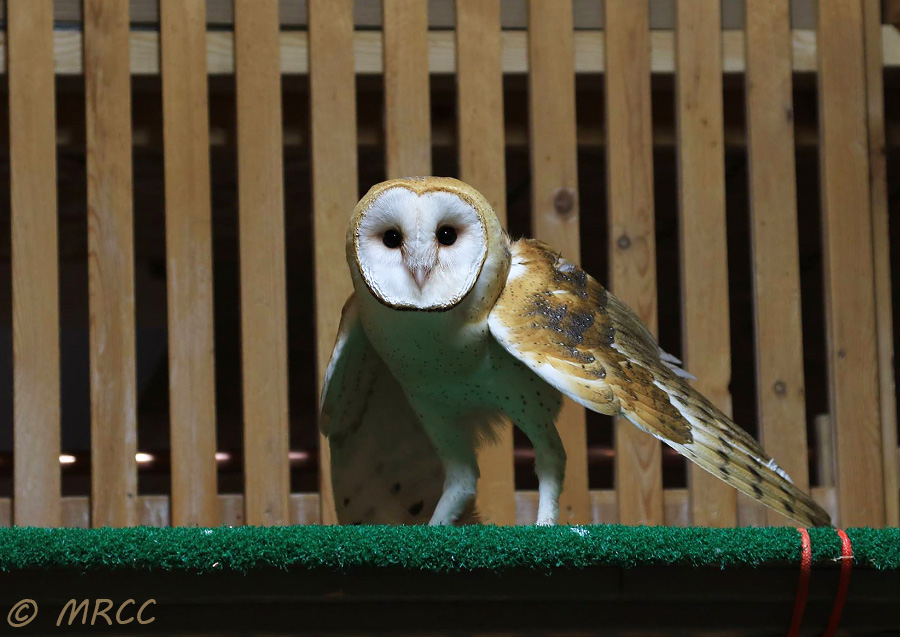
Copyright MRCC. Image used by permission
This is the same owl at MRCC in Bozeman during recovery. Thankfully there were no broken bones but there was significant soft tissue damage that would take time to heal. But he wouldn’t eat in captivity for a long time and that was of great concern for obvious reasons.
But eventually he began to eat, healed up, and was ready for release.
Copyright MRCC. Image used by permission
And MRCC didn’t just take him to the nearest open field to release him. They drove him all the way back to the Centennial Valley, a distance of about 190 miles (much of it dirt/gravel roads), and released him in the approximate area where Mia and I found him on the wire. Barn Owls are rare to unheard of in MT (it’s too cold up there and they don’t migrate) so they wanted to release him in an area he was familiar with that had been of his own choosing.
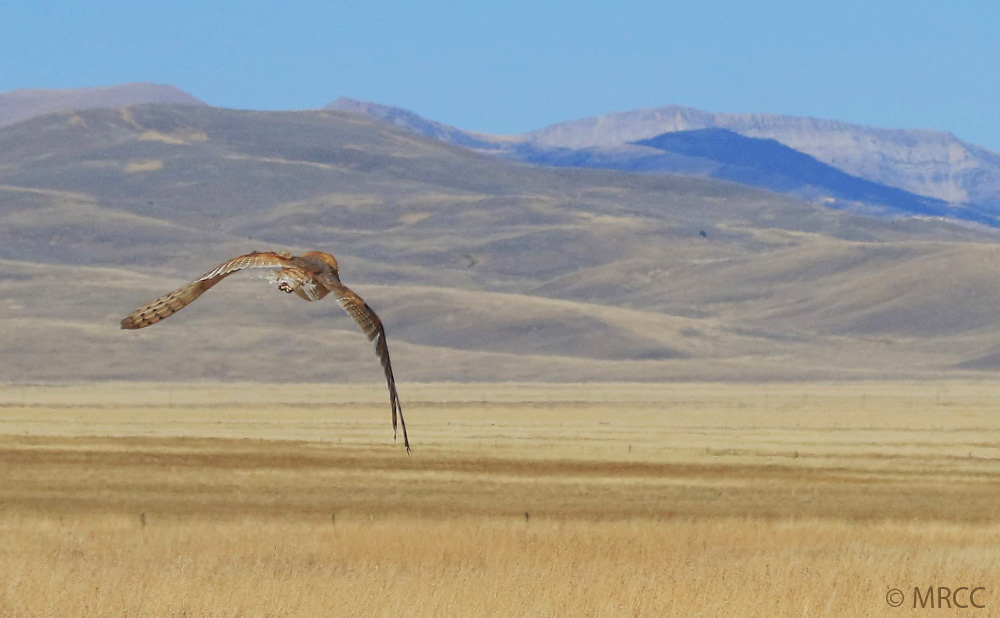
Copyright MRCC. Image used by permission
And here he is, flying toward the foothills of the Gravelly Range. And to freedom.
So why am I telling this story again? I wanted to make the point that MRCC was the vital cog in this wheel. Without them the efforts of everyone else involved (and there were many) would have been fruitless. The owl simply could not have survived without the healing facilities and efforts of a host of staff, volunteers and veterinarians at MRCC. And all that is expensive so I think those of us who love birds should do whatever we can to support bird and wildlife rescue, rehab and educational organizations. And there’s more than one way to do it.
Some volunteer their time, labor and love to those organizations as a way of paying back. Arwen (mentioned above) is in example as are many of my friends and blog readers including Tana Peery Hunter, April Olson and her daughter Haley and many others. But that’s something I simply cannot do for a reason that may seem wimpy to the extreme but it is what it is. I’ll try to explain.
I’m an animal person through and through and I’ve had a dog most of my life. My first dog, Skippy – a cocker spaniel, was born on the day I was born and my folks bought him for me soon after. I had Skippy for 13 years – he loved hunting “gophers” and he was the perfect companion for a kid growing up on a remote Montana farm.
My last dog was a Cavalier King Charles Spaniel named Tommy (he already had that name when I bought him as a pup). Talk about attached – me to him and vice versa! Tommy went almost everywhere I went unless I was working. He was fine home alone all day but when we were traveling it was another story. The only way he would relax when I was visiting out-of-town family and friends and had to leave him for a few hours was for me to throw an article of my clothing on the floor that smelled of me. He would immediately curl up on it and stay there contentedly until I returned. That might annoy a lot of folks but I found it endearing.
Sandwiched in-between Skippy and Tommy were a handful of other dogs but one of them stood out. His name was Jake.
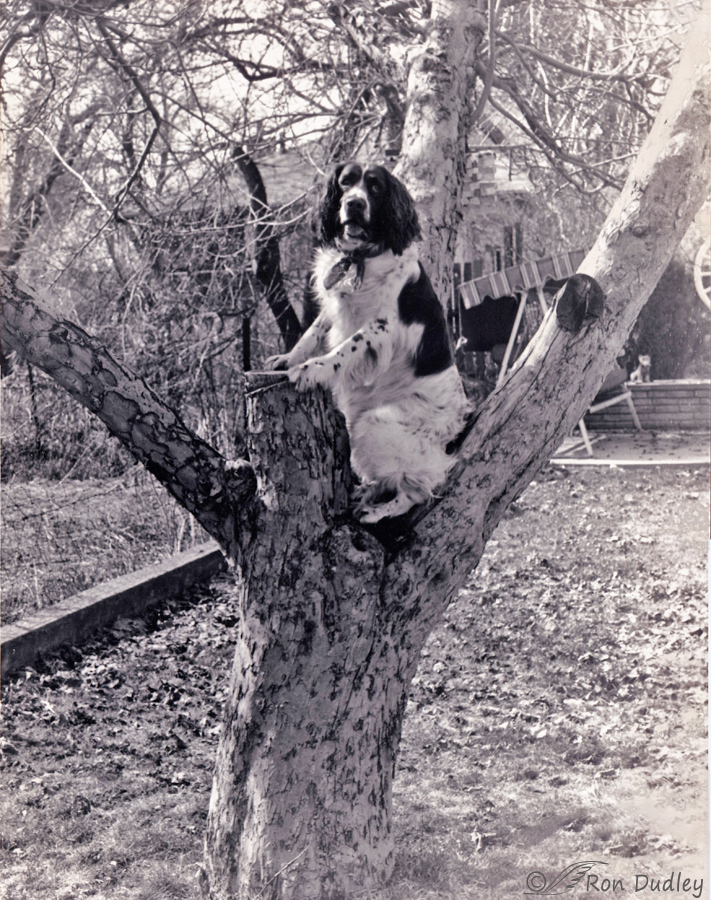
Jake was a Springer Spaniel (yes, I have a thing for spaniels) who loved to climb trees. This photo is black and white because I had my own darkroom back then. Jake was a drooler and rambunctious but I loved him. He got me through some tough and lonely times, including a divorce.
I could go on and on about my dogs but I’ll make my point now. Dogs just don’t live long enough and I’m an emotional wreck for weeks or months when I lose one. I take their loss much too hard. I had to have Jake put down late in the evening on Christmas Eve during a visit to see my parents near Montrose, Colorado and I was a basket case for much too long. I haven’t had a dog for over ten years now, largely because I just can’t handle losing them.
And knowing how I feel about animals, raptors especially, I just know how I’d react to the tragic loss of birds I’ve been caring for if I volunteered for rehab or rescue organizations. I would just become too attached so I don’t do it, never have and never will.
But there are other ways to pay my debt to birds and support organizations that work on their behalf. I’m a bird photographer and these types of organizations often need quality photos of birds for promotional and fund raising purposes so when asked I donate my images without hesitation. I also make monetary donations when I feel like I can. These organizations typically operate on a shoestring budget so donations of cash or supplies are critical. The recipients of my support include Wildlife Rehabilitation Center of Northern Utah, HawkWatch International, Montana Raptor Conservation Center, Cascades Raptor Center, The Peregrine Fund and others.
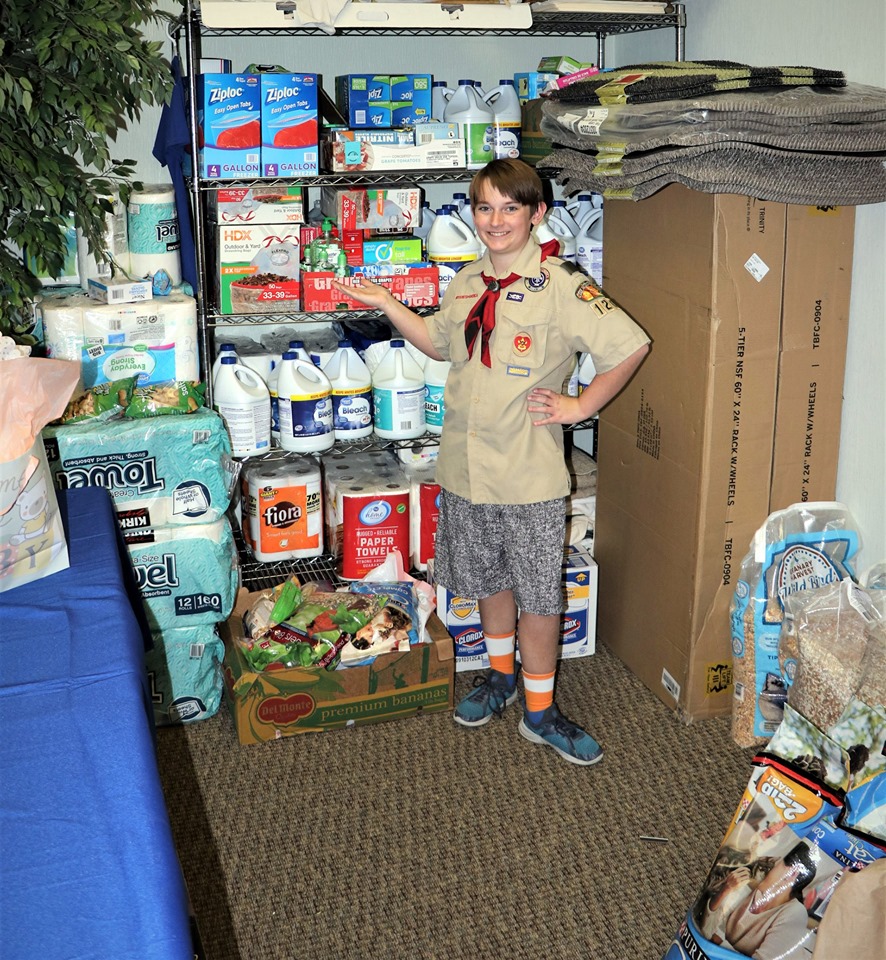
Copyright WRCNU. Image used by permission
Meet Rory, an Eagle Scout candidate whose efforts on the behalf of Wildlife Rehabilitation Center of Northern Utah resulted in a motherlode of donated supplies. You can imagine how many supplies rehab organizations need. WRCNU goes through 12 rolls of paper towels each and every day and the rest of their list of needed supplies is almost endless. Rory is proof that an individual can make a huge difference.
So there’s some way that everyone can help. Volunteer, donate supplies, donate cash or be creative depending on your own situation. Wildlife rehab and education organizations are found in virtually every city and many smaller towns and each of them is staffed by employees and volunteers with huge hearts and an endless need for equipment and supplies. Please help if you can.
Ok, I’m done. This turned out to be a marathon post so if you got through the entire thing I applaud you. If you couldn’t wade through all of it, blame Arwen and not me… 🙂
Ron
Notes:
- I don’t mean to imply that if you don’t support organizations like these you’re not supporting birds. It goes without saying that there are many other ways to be a bird advocate and I know that many if not most of my readers actively engage in some of them. We do what we can.
- Near the bottom of this page is a list of supplies needed by WRCNU. Their list is very specific and I suspect it’s typical of similar organizations so if you choose to donate supplies be sure they’re items that can actually be used.
- Staff and volunteers of rehab organizations remind me of nurses. My mother and both of my sisters were nurses and I well remember how heartbroken mom was when she’d lose a patient. I admire anyone who is willing to pay that heavy emotional price in support of their patients, human or otherwise, but I’m not one of them. I’m a lightweight…


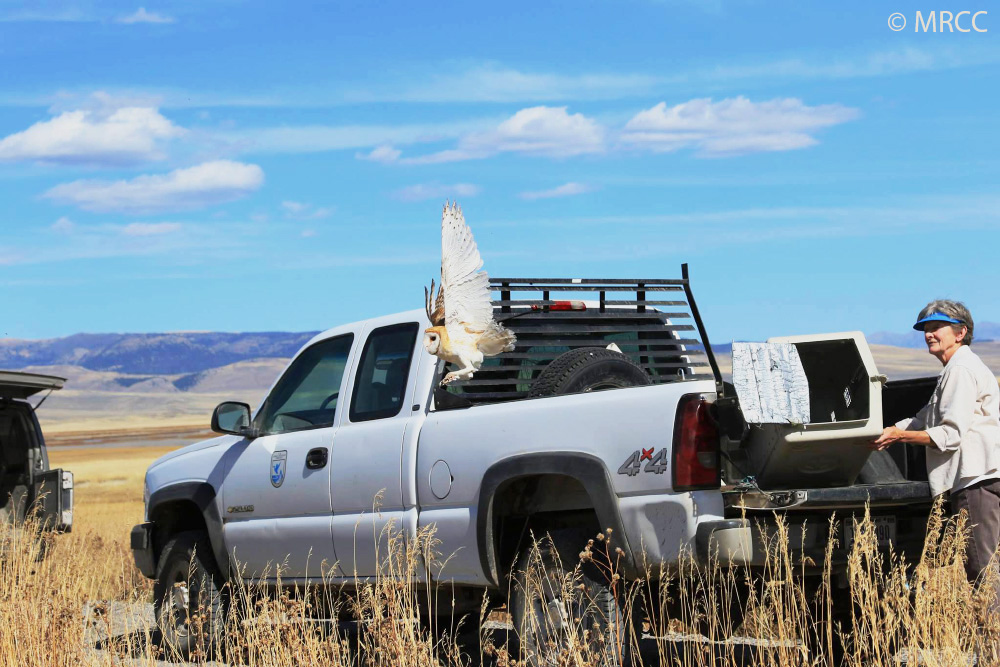
That was a heart-warming story about the owl and the recovery. I was so happy to see it being released in the wild. I love dogs, our family had a Wire-haired Terrier and an American Spaniel and then have dog-sat different friends’ dogs who all have a piece of my heart. As well, I have been thinking of getting more involved with birds, and feel inspired by what you have written, am sure the opportunity will present itself.
Thanks, Jane. Good luck with your decision – it’s a big one for both you and for birds.
Ron, those of us in SE and Central Utah would like to recognize the wonderful work done by Debbie Souza-Pappas at Second Chance Wildlife Rehabilitation, in Price, Utah. Second Chance is a non-profit, charitable organization, dedicated to sick and injured wildlife including raptors. Debbie began her rehabilitation facility in 1994, and has been expanding her facilities with recently constructed mews. If you would like to know more about Debbie, her website is http://www.wildliferehabprice.wix.com/2ndchance.
Thanks for all you do to educate photographers, birders and naturalists about the wonders of what is around us. Many members of the Moab Bird Club visit your blog regularly.
Marian, I’ve been aware of Second Chance for some time now but I know very little about them. I’ll be sure to visit your link – thanks for providing it.
Ron, what a heartwarming blog. Several of your readers are active in animal/bird rescue and rehabilitation which is wonderful I also felt a tug at my heart to see the rescued owl fly off. I can’t imagine how you felt. I too could not work in rehab as I would not be able to handle the sad stories.
I love the story about your dog friends, particularly Skippy who was so attached to you. Thank you Ron for all you do to inspire and inform people.
Thanks, Alice. Ol Skip was a special dog for me and I had a tough time losing him when we were both 13 years old.
A big thank-you to everyone who works and volunteers in wildlife rehab!!! 🙂 Joan and Martha, thank you for adopting the senior dogs! 🙂 We’ve had some great adoptions of seniors and long-term residents recently at our local spca. Woo Hoo!
I try to do my part volunteering with our local spca (I’ll insert my plug that each local spca and humane society is independent — there is NO national umbrella organization for either one — so please give locally). I’m late to the party today because my foster kittens had their checkups/2nd round of shots earlier today and I had my own dr appointment after.
And yes, I tear up when I see the beautiful Barn Owl fly off to parts unknown (and at any news about Galileo).
Marty, I had a dr. appointment today too. Another one tomorrow. I’m sick of ’em.
I am thrilled for the Owl. I thought for sure it wouldn’t heal enough to be returned. Thank goodness You and Mia were in the area, and rescued the Owl. And a big thank you for all who helped the Owl recover. And to drive that far. Perfect!
Thank you, Jean.
Once again, you have tugged at my heart, Ron. Like Mikal, I have a very small operation in Tulsa Oklahoma, taking birds of prey. For years I also took native songbirds but had to stop taking them when I decided to go back to the 40 hour a week grind at a “regular” job. One of the reasons for returning to the work force was the expense of rehabbing. I usually order frozen mice and quail twice a year, and each order runs around $450.00. I do not fund raise, but instead choose to foot the bill myself. Repairs on my flight caging is another expense, but it’s all by choice. I was brought up by a mother who taught me that we all owe the world something in return for what we take from her. My love for all creatures avian in particular led me to become a permitted rehabber ten years ago.
So thank you for your kind words. I understand your deep love for your animals. I too have grieved the loss of a special cat by the name of Daisy that I lost to leukemia in 2014. I still weep over some of the decisions I made during the last few days of her life; so I could never think you “silly” for loving like you do.
Your contribution to educating the public has no measure; I’ve believed for a long time that saving one bird at a time (through rehabbing) won’t really make a difference in the grand scheme of things; but educating the general public-THAT will make a difference. And you do that, daily. Thank you, Ron. So very, very much.
Your comment tugged at my heart, Leslie. I’ve always thought that education was the key but then I’m a retired teacher so I’m a little biased about the powers of education. Thank you.
Thank you for recognizing rehabbers! Truth is that none of us can do the job without support from others. The mouse bill at my tiny rehab is about $600 a month. So even though I work out of my home and am a full time volunteer, I am not working alone. As for the emotions, we know that every patient is in really dire straits, unable to escape being captured. In other words, consider it dead coming in the door. When it’s possible to help it recover to continue it’s wild free life- well nothing else has given me the righteous feeling that my life has mattered. That’s priceless. So,thank you to everyone who makes the work possible. From the bottom of my heart, thank you! Mikal Deese, ON A WING AND A PRAYER, Corrales NM
Mikal, your “consider it dead coming in the door” philosophy makes perfect sense. That’s what I would have to do if I were to survive as a rehabber but I probably wouldn’t have thought of it myself.
Corrales? I volunteer in Rio Rancho for Hawks Aloft. 😀 Let me know if I can help you as well.
This post speaks (loudly) to so many of us.
I also had a tear or two (of the happy variety) when that gorgeous barn owl was released, and have cried oceans of tears for animals over the years. I grew up with a German Shepherds I learned to walk pulling myself up on his tail, and teethed on his ears. Sadly he was baited in his yard one night. He had been trained not to eat food except at home, but the lowlife lobbed the bait into his territory. Every dog in the block who was out that night died.
I support a few charitable organisations but one which is particularly dear to me is a Wildlife Rescue. The job that they do is hugely important and equally hugely underfunded.
I hope they caught the anal sphincter who did that, EC. If not I hope he eventually developed a conscience and suffers withr the guilts for the rest of his life (not likely, I know…)
I have to admit your post of the Barn Owl brought a tear of joy to my eye. Seeing him released, understanding that he was brought back to his home range, what a wonderful new beginning to when you untangled him from the wire fence.
Man, many thanks for all that you and Mia do and the many friends that you have with the thought of justice for wildlife. It is greatly needed today!
Thank you very much, Dick.
Ron, excellent suggestion from Wally Jones about having contact info with you. Even though I know who to contact locally his suggestion made me realize that I don’t have their contact info with me here as I am out hiking or photographing. I just put a card in my wallet with the phone number of AZ Fish & Game, Liberty Wildlife Rehab in Phoenix, and our local USFS biologist. Thank you Ron and Wally.
Everett Sanborn, Prescott AZ
Everett, see the second comment Louise made below about a phone app for that purpose.
Once again Ron, thank you for your support and kind words. It truly takes a village to help our wildlife by protecting their natural habitat and individual animals when wildlife is injured or orphaned due to human contact.
Rehab is physically taxing with long hours and an emotional roller coaster, I don’t know how rehabbers do it for 30+ years and stay physically and emotionally healthy!
All Wildlife rehabs and educational organizations need any support people feel they can offer or afford. Arwen, thank you for getting involved. Every thing poops and cleaning cages is a great way to help. I think despite the grime you will find it rewarding. As I would spend a couple of 10-12 hour days a week power washing kennels, carpets and cages, washing endless towels and dishes, I would think of the animals I was helping. Many I had personal contact with to feed and watch grow and heal, so if you saw me smiling while cleaning it was the success stories I was thinking of.
Sallie, Kudos! I don’t know how you did it alone in your home. Many animals require around the clock attention, and there is not a break for the individual rehabber physically or emotionally.
It anyone is interested in reading a couple of good books by rehabbers here they are.
Fly Away by rehabber Suzie Gilbert. She is an individual at home rehabber who struggles with how rehab effects her person life with her family and with the emotional side of rehab. (yes, some of this story rings true with my experience)
Touching Wings, Touching Wild by rehabber Ronnie K. James. I like the way Ronnie chooses to only share the positive stories. Too often rehabbers get stuck on Rehabbers remorse that can eat you alive. I met Ronnie at a few of the NWRA conventions. She is an example of many rehabbers who inadvertently start a new career after retirement. It all starts with one simple thought “How can I help?”
very well said, April – the voice of experience. And thank you for the tips about those books.
Thank you Ron! Appreciate all your work to put this together and inspiring words; every little bit helps, just one step at a time …
Thank you, Buz. But it’s you folks at WRCNU and other rescue and rehab groups that truly deserve the credit.
A truly important post, Ron. Thank you!
We just had a very special dog put down after allowing us to be his humans for over 16 years. Emotional? Yeah.
If I may add one note to all of the excellent tips and information provided by you and others. As photographers/birders/campers/explorers, when we plan to visit a particular area, be sure to include as part of our trip research the contact information for rehabbers/animal rescuers in that specific area. Tuck the info in our pack or purse or phone. It’s very upsetting (as I know from sad experience) to find a bird in need of help and not know how to go about it.
Again, Ron and Mia, thank you both SO MUCH for all you do!
“It’s very upsetting (as I know from sad experience) to find a bird in need of help and not know how to go about it.”
That’s EXACTLY where I was when we found this owl on the wire, Wally. We were out in the middle of nowhere and I was unfamiliar with any rescue organizations in the area. If Bill West, manager of nearby Red Rock Lakes NNR hadn’t come along and taken that bird off our hands we (and the owl) would have been up that proverbial creek without a paddle. Bill, of course, knew exactly what to do. And next time I will too.
Sympathies about losing your dog. At least you had him for that long – pretty good for a dog.
There is a phone apps you can download called Animal Help Now! – for wildlife in need of rescue. It’s available through the Apple App Store. You can put in information, even a photo of the animal; the app uses your GPS location to find the closest help. And then you click ‘call now’ and you get through to the nearest facility. Of course, in many cases, the nearest facility may be quite a distance away, but I would hope whomever answers can provide advice, at any rate.
I downloaded this right away! I was visiting in California when a couple said they’d found a beached seal. I had no idea who to call. I’m going to post this on my fb page—perhaps the only healthy use of that media.
👍
Excellent, Louise. I’ll be investigating that app.
Louise, I second your recommendation of Animal Help Now! I was just about to post about them when I saw you had beat me to it! I look forward to seeing you again on down the road!
Great post, Ron! 🙂 Joe is the REAL emotional one with dogs so, when it’s time, I handle that – not wanting them to suffer unduly overrides my pain at losing them….. 🙁 Our “yard” and surrounding areas near the creek are definitely “rough” with snags/brush/cottonwood trees and many unmowed areas that the wildlife do enjoy even if we don’t enjoy some of them – i.e. Whitetail Deer/Beaver/Buzztails and, at times raptors after my clucks…… 😉 There is always “something” people can do to help. Kudos to all those who do rescue in whatever form! 🙂 Information/Education key to much of it……
Thanks, Judy. I wish I had a yard like you do, “pest” critters and all…
Thank you for all you do for animals, Ron. As you point out, we can each help out in the way that suits us best. I do fundraising for a local wildlife rehab center. Going in to feed the animals would be too heartbreaking so I help by bringing in the money we need to buy supplies and pay the wonderful wildlife rehabilitators without whom we wouldn’t exist. As for dogs, I hear you; we lost our old dog in January and I was a wreck for weeks. But I love dogs so much I went out and got another rescue a month ago. I love the release photos of the owl – releases are the best part of wildlife rehabilitation!
“I do fundraising for a local wildlife rehab center”
That’s a wonderful alternative for those of us who can’t or won’t endure the heartache, Linda. Wish I’d thought to mention it.
Hey now! Lol. But you give in a way you may not know. You remind me every day of the beauty of our world (even the hard posts ). You make me aware of others who have the same dedication and passion. My fellow commenters remind me I’m not the last of a dying breed. By educating me, you are volunteering your knowledge and time. I can’t do cat rescue for the reasons you list above. I’d bring them all home. So thank you for your daily reminders, professor. 😀
It always makes me smile when you call me professor, Arwen – deserved or not. And thank you for the very kind words.
Thank you, Ron, from all rehabilitators. I have been a rehabber volunteer since 1999. I worked with a small group of trained,licensed home rehabilitators for a long time (I’m still a member of that group), but the year I lost 8 Western Screech Owls in my care, I gave up that position – not because I had done anything wrong with the birds, though always we can do better as we learn or get more up-to-date medications – but because of the burden of being the only one to bear the weight. I went to the California Raptor Center, where staff and about 40 volunteers share responsibilities. Over the years I have done almost everything, from cleaning (which I perversely enjoy) to feeding, to medicating, to education talks. It still hurts to lose a bird you’ve worked with, be it for days or for years, but not being the sole person responsible alleviates the anguish, reducing it, for me, to a bearable level. Nothing we do in life is without its accompanying pain. I’m 80 now and have contemplated giving it up – it’s a 150 mile round trip from the center to my house. But the feelings of ease and connection I get when I walk into the compound and greet the Golden Eagle who has been there longer than I have, keep me coming back.
Your dedication (and apparent tolerance of anguish) are impressive, Sallie. I can hardly imagine how you felt losing that many owls in a single year.
Outstanding and much needed post Ron. I have to admit to getting a little chocked up reading the owl story. The picture of that poor guy hung on that barbed wire fence really got to me. A high-five to you and Mia for rescuing him and super kudos to MRCC for their recovery work and for taking the time and trouble to drive him all the way back to his origins. Twice over the years I have rescued birds in the back yard and gotten them to a wildlife rehab place. Once back in Orange County I took a wounded Kestrel in, and then here in Prescott I discovered a wounded Roadrunner in the backyard and did the same for him/her. It took me at least an hour to capture him without doing him further damage. I know the Kestrel was repaired and put back into the wild, but I never did find out about the Roadrunner. Right now we have our long time Lynx Lake resident male eagle at a wildlife shelter. He was attacked and severely damaged by a rouge male who came into the territory and challenged him for the female. Luckily someone found him and took the time to notify Fish and Game and stay with the wounded eagle until they could come and get him. That was a couple months back and he is still in rehab. No way could I ever ignore any form of hurt wildlife. Thanks for posting this.
Everett Sanborn, Prescott AZ
Everett, that owl chokes me up too, especially the photo of him flying free toward the foothills after being in captivity for so long. I hope your eagle recovers eventually and can be released back into the wild.
Thank you, thank you, thank you for another wonderful, informative post, Ron. I’ve been a volunteer for Wild Bird Rehab in St. Loius for 20 years, and our mission is to care for injured and orphaned songbirds until they can be returned to the wild. I can still recall the first Yellow-billed Cuckoo I had to euthanize after it suffered head trauma from flying into a window. The rewards are amazing, even when the days are difficult. But not everybody can find the time to volunteer. For those who can’t, they can help the birds by planting native! Native trees, grasses and shrubs require less care and provide much needed food and shelter when birds need it most. Thanks again, Ron!
Diane, I know of rehabbers who after many years of volunteering had to quit because of the emotional price they pay. I admire each and every rehabber out there. I just don’t know how they do it. Great suggestion about planting native. Like I said there are multiple ways we can help.
Senior Dogs. What Joan said. Believe me, the dogs deeply appreciate it.
I’m sure they do, Martha. And they deserve it too.
Thank you to every animal lover out there. We need all the exposure, help, money, and activism to achieve our goals. Those goals being:The respect, love, care and kindness and support for all living beings. There are many ways to do this and I hope everyone will be aware of the many injustices that are going on in the wild world as well as with our pets. Education is the key. Reading newspapers, wildlife journals and publications as well as blogs like the wonderful one that Ron produces are a good place to start. But the best thing you can do is tell your friends and neighbors and family and get them to be active in this area. Often times legislators hold the keys, and contacting members of our governmental organizations also is important. If you don’t say or do anything they don’t think you care. Thanks Ron for all you do.
I agree with all of your suggestions, Tana. And of course my appreciation of your efforts in this field is magnified by your care of Galileo. Love that bird!
Last year Cascades Raptor Center in Eugene, Oregon had 30,000 visitors. Speaks Loud of Louise and her staff and volunteers. Expansion is coming,so my wife and I support what Louise is doing.
I agree, Steven. Louise is one of my heroes and she occasionally comments here and includes excellent information and advice. If I remember correctly, and I think I do, Louise has one of my magpie prints hanging on her office wall.
The magpie print is on a wall in my house, actually – too selfish to put it in my office. 🙂 And thank you for your kind words about rehabilitators and the work we do, Ron – and the work we also do through education, Steve. In rehab, we work with one bird at a time; when we speak to a group or share the magnificence of these birds in person, we potentially impact hundreds of birds. Convincing one person to stop using a rodenticide or taking down barbed wire, or leaving snags as nesting sites, planting native plants as a wildlife oasis or corridor … it’s all critical. This blog is a great example of sharing respect and appreciation – we’ve all learned lots, I know, through Ron’s observations. Together, I believe we make an impact both directly and indirectly on the natural world we all love.
Well, I’m glad my memory was at least mostly correct, Louise. These days sometimes it isn’t.
Thank you for all you do. When I talk to other rehabbers they tell me that CRC has one of the very best reputations in the business and much of that credit belongs to you.
Thank you, read to the end. I take in senior dogs older than 10, that people can’t care for. I might have them for a few years, or less, but they deserve a nice quiet retirement, which we all deserve.
Love the photos always and your explanation.
Thanks again. Joan
I applaud your stamina, Joan. And your big heart.